When to replace a timing belt
Why you must replace a timing belt on schedule
If your engine is an overhead cam design it most likely uses a timing belt to rotate the camshafts. Timing belts don’t last forever and you must replace a timing belt according the car maker’s maintenance schedule. Replacement intervals vary by car maker and engine style, but can last from as little as 60,000 miles to as long as 110,000 miles.
When to replace a timing belt
Replace a timing belt when:
• You reach the time and/or mileage replacement interval listed in the carmaker’s maintenance guide
• If you don’t drive a lot and years have gone by since the carmakers recommended change interval, you must have the timing belt inspected. If you find any of these conditions, replace the belt:
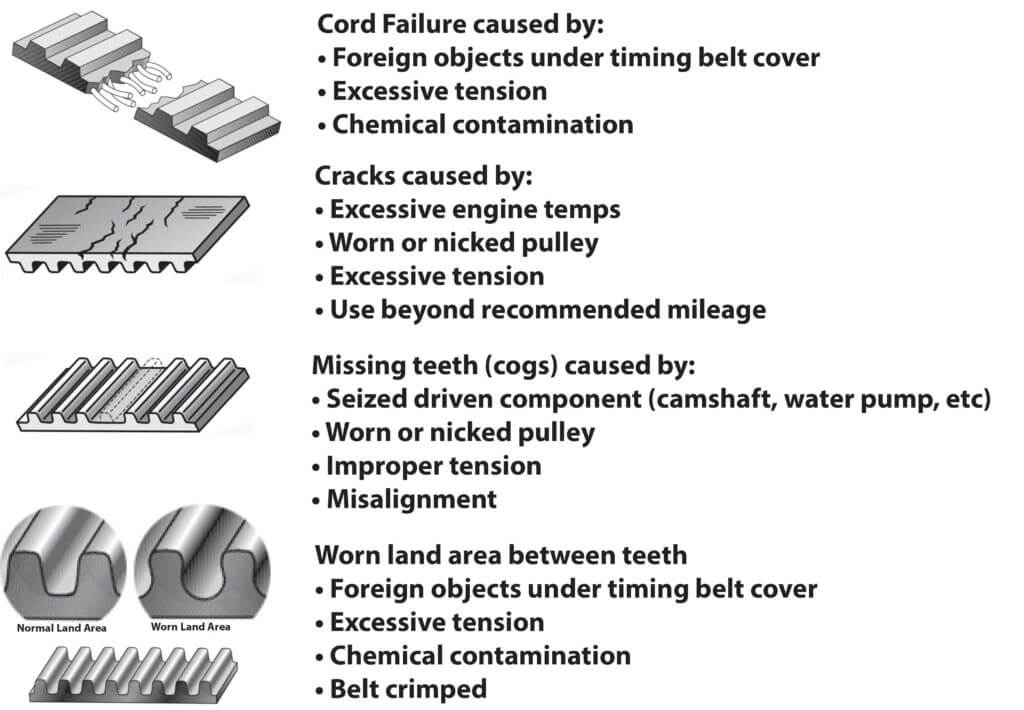
Conditions that require you to replace a timing belt outside of the mileage recommendation
Why is it so important to replace a timing belt at the recommended intervals?
Some engines are designed with a very small clearance at the top of the cylinder when the piston reaches the top of its travel. If the camshaft is out of time with the crankshaft the intake or exhaust valve may not be fully closed when the piston reaches the top of its travel. When that happens, the piston hits the valve(s) damaging both the valve(s) and piston. 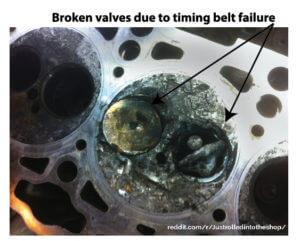 This happens on “interference” engines. See this post to learn more about interference engines. If the timing belt breaks on an interference engine while it’s running, the result is often catastrophic engine damage costing around $2,500 to $4,000.
This happens on “interference” engines. See this post to learn more about interference engines. If the timing belt breaks on an interference engine while it’s running, the result is often catastrophic engine damage costing around $2,500 to $4,000.
Other engines can survive a broken or out-of-time timing belt. They’re referred to as “free-wheeling.” If the belt breaks on that style engine, the valves will continue to open and close for a short while, but won’t hit the pistons. The engine will stop running.
Regardless of the type of engine in your vehicle, ignoring the recommended timing belt replacement is a really bad idea. In a freewheeling engine, the broken belt will cause a breakdown requiring you to call a tow because the engine won’t restart after quitting. You won’t save any money by ignoring the timing belt replacement because it’ll eventually break and you’ll have to pay for the belt replacement and a tow. If you ignore the belt replacement with an interference engine, you’ll have to pay for a two and a new engine (up to $4,000).
What else should you replace when replacing the timing belt?
The timing belt is kept at the proper tension by the timing belt tensioner. 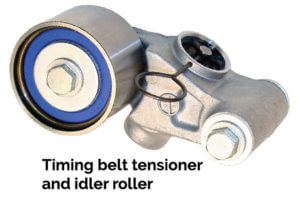 The tensioner presses against the belt with smooth idler roller. If you reuse the old tensioner and it fails, the result will be the same type of damage as a broken timing belt. In addition, the timing belt can wear grooves into the idler roller, causing damage to the new belt. The idler roller rotates on a bearing that can wear out, so it should be replaced with the belt. In fact, most shops won’t provide a timing belt warranty unless you replace all those components together.
The tensioner presses against the belt with smooth idler roller. If you reuse the old tensioner and it fails, the result will be the same type of damage as a broken timing belt. In addition, the timing belt can wear grooves into the idler roller, causing damage to the new belt. The idler roller rotates on a bearing that can wear out, so it should be replaced with the belt. In fact, most shops won’t provide a timing belt warranty unless you replace all those components together.
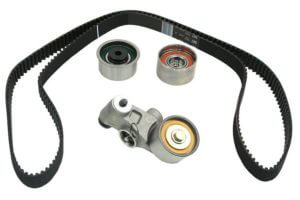
Should you replace the water pump when you replace the timing belt?
In some engines, the water pump is also driven by the timing belt. 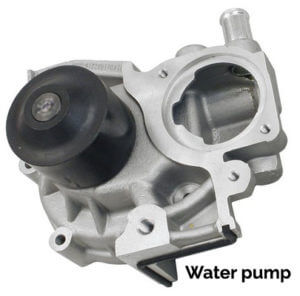 In those designs, the belt must be removed to replace the pump. Water pumps often fail before the engine reaches 200,000 miles, so most shops recommend replacing the water pump at the same time as the timing belt because once the timing belt is off, the only extra expense is the cost of the new pump and the labor to remove it and drain and refill the cooling system.
In those designs, the belt must be removed to replace the pump. Water pumps often fail before the engine reaches 200,000 miles, so most shops recommend replacing the water pump at the same time as the timing belt because once the timing belt is off, the only extra expense is the cost of the new pump and the labor to remove it and drain and refill the cooling system.
Reasons to replace your water pump with the timing belt
Let’s say your vehicle requires a new timing belt at 90,000 miles and you plan to keep the vehicle until it no longer runs. Your engine will need probably need a new water pump before its next timing belt replacement job at 180,000 miles. If you don’t replace the pump at 90,000 miles and it fails between 90,000 and the next timing belt change, you’ll have to pay the full labor cost of removal and replacement again. If you feel you might be in a better financial position at a later time, then don’t replace the water pump when you replace the timing belt at its first change. Here’s a scenario where that pays off.
You replace just the timing belt at 90,000 miles. At 140,000 miles the water pump starts leaking. You replace both the timing belt and a water pump. You’re now good until you reach 230,000 miles—which is most likely near the vehicle’s end of the engine’s life.
Should you replace the crankshaft and camshaft seals?
The crankshaft and camshaft seals prevent oil from leaking out of the engine. 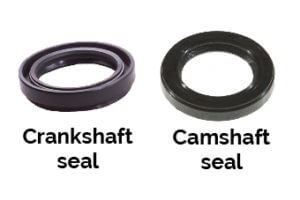 Shops recommend replacing these seals during a timing belt replacement since the bulk of the labor is already done. The only added expense is the cost of the parts (usually less than $20) and about a half-hour of extra labor. If the technician finds that the current seals are leaking, have them replaced. However, if the seals aren’t leaking, chances are better than 50/50 they’ll never leak.
Shops recommend replacing these seals during a timing belt replacement since the bulk of the labor is already done. The only added expense is the cost of the parts (usually less than $20) and about a half-hour of extra labor. If the technician finds that the current seals are leaking, have them replaced. However, if the seals aren’t leaking, chances are better than 50/50 they’ll never leak.
Should you have the cooling system flushed at the same time as a timing belt replacement?
If you’re having the water pump replaced, the technician will have to drain a portion of the cooling system. Most carmakers recommend a coolant change around 100,000 miles, so shops usually recommend a cooling system service at the same time. It’s a good idea, but only if the shop makes it a package deal. Remember, they have to drain a portion of the cooling system to replace the water pump. You should get a partial discount on the cooling system service if you’re getting the timing belt and water pump replaced at the same time.
How to avoid being ripped off when replacing a timing belt
Replacing a timing belt requires the removal of many parts from the front of the engine. In most cases, the technician must remove the serpentine drive belts to the alternator, A/C compressor and power steering pump. Once the timing belt is removed, the bulk of the labor is already done for a water pump, camshaft, crankshaft seal replacement. Here’s an example of the flat rate labor times for a 2008 Subaru Outback
Labor hours to remove and replace the timing belt 2.3
If done at the same time, here are the extra flat rate labor hours
To replace the following parts
Crankshaft seal 0.5 hrs
Camshaft seals 0.4 hrs
Oil pump seal 0.5
Idler pulley 0.1 hrs
Timing belt tensioner 0.1 hrs.
Water pump 0.7 hrs.
So the total labor would come to 4.6 hrs.
Avoid getting ripped off when you replace a timing belt
Unscrupulous shops double-dip on the flat rate labor charges. For example, they’ll charge you 3.9-hrs. to replace the timing belt, camshaft and crankshaft seals, oil pump seal and timing belt tensioner. But they’ll charge you an additional 3.0-hrs. to replace the water pump. As you can see above, if you replace the water pump when you’re doing the timing belt, the extra labor is only 0.7 hrs. The 3.0 -hr labor time is for replacing the water pump as a standalone repair, without a timing belt replacement. In another example, a shop may charge you 4.6-hrs. to replace the timing belt, seals, and water pump, but charge additional labor to replace the serpentine drive belts. But they have to remove and replace those belts as part of the labor to do the timing belt. If those serpentine drive belts are worn and you authorize the shop to replace them, you should be charged for the parts, but you shouldn’t be charged extra labor.
How can you tell what’s covered? Simple. Ask the shop to show you the flat rate guide. Here’s an example. The timing belt job for this Subaru shows the labor for the base timing belt job at 2.3-hrs. Then it lists the additional items as “combinations.” That’s the extra labor required to replace those components if you replace them at the same time as the timing belt.
Where’s the best place for a timing belt replacement?
Replacing a timing belt is labor-intensive, so you may be tempted to avoid the dealer due to their higher hourly labor rate. However, installing a timing belt requires scrupulous attention to detail and engine-specific proper tools. If the technician isn’t familiar with the design of your engine, they can install the belt improperly, causing poor performance or damage. This is one of the few maintenance repairs where it may be in your best interests to use the dealer service department. Or, find an independent shop that specializes in your car make. Simply ask the shop how often they work on your car brand and how many times they’ve done a timing belt job on that particular engine. If they don’t routinely work on that brand, ask them for a recommendation of a shop that does.
©, 2016 Rick Muscoplat
Posted on by Rick Muscoplat
